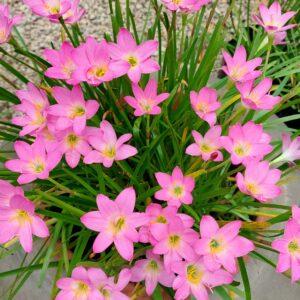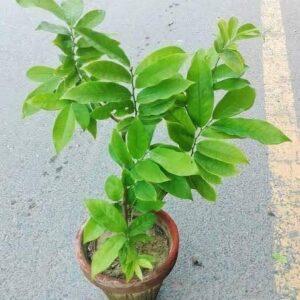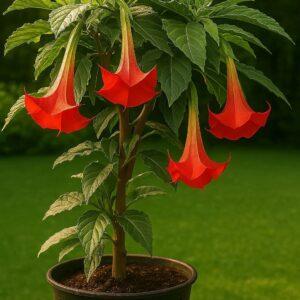HeliconiaThe Exotic Tropical Showstopper is Heliconia.
The tropical perennial plant known as helonia, sometimes known as the lobster claw, false bird of paradise, or wild plantain, is well-known for its striking, vibrant bracts that resemble a bird’s beak or a lobster’s claw. It is a popular addition to tropical gardens and flower arrangements because it originates from Central and South America and grows well in warm, humid environments.
Heliconia has more than 200 species, with heights, bract forms, and colors that vary widely, including red, orange, yellow, and pink, frequently with striking color combinations.
🌿 Overview
Heliconia spp. is the scientific term.
Typical names: Lobster Claw, Wild Plantain, False Bird of Paradise
Herbaceous tropical perennial is the plant’s kind.
Height ranges from 2 to 15 feet (varies by species).
Range: 3–6 feet
Leaves: Big, paddle-shaped, and similar to banana leaves
Flowers: little and concealed within striking, waxy bracts
Blooming period: Spring to fall; year-round under perfect tropical circumstances
Demand for light and temperature
Sunlight:
Likes light that is strong and indirect
Humid environments may tolerate full sun.
In extremely hot and dry regions, partial shade in the afternoon is preferable.
Temperature:
Best temperature range: 20–35°C (68–95°F).
Not frost-tolerant; minimum temperature of 10°C (50°F)
Ideal for tropical or subtropical regions (USDA 9–11).
🔥 Heliconia thrives in humid conditions. If cultivated inside or in dry regions, misting is helpful.
💧 Watering Schedule
Heliconia requires consistent moisture, particularly during the growing season.
Young plants:
Water every two to three days
full grown plants:
In the summer, water twice weekly.
Water less often during the rainy season or during the winter.
The soil should always be damp but not saturated with water.
Retain moisture and shield roots from heat with mulch.
Requirements for fertilizer and soil
Soil:
Loves loamy soil that is rich and drains well
pH: Between 6.0 and 7.0, which is considered somewhat acidic to neutral.
Include organic materials such as compost, peat moss, or cow dung manure.
Fertilizer:
Apply a balanced fertilizer (such as 10-10-10 or 14-14-14) every 4–6 weeks during the growing season.
Enhance flowering by using phosphorus-rich fertilizers, such bone meal.
Organic choices include seaweed solution, banana peel compost, and vermicompost.
⚠️ Excessive fertilization can lead to excessive leaf growth with few blossoms, so avoid overdoing it.
Maintaining and pruning
To regularly deadhead old or faded bracts and leaves to:
Enhance airflow
Lower the risk of illness
Promote fresh growth
Since helonia flowers only bloom once every stem, cut them down to the base after the blooming stalk has finished flowering.
Trim any yellowing or broken leaves as necessary.
Wear gloves when pruning since some people may develop skin irritation.
Approaches to Propagation
The most efficient method is rhizome splitting.
Ideally carried out during the spring or at the start of the monsoon season
Divide the subterranean rhizomes of the plant after you have dug it up, making sure that each segment has at least one shoot or eye.
Replant in well-prepared soil right away.
Seeds:
It can be grown from seed, but it grows slowly and erratically.
May need scarification and could take months to germinate
Rhizome division is a dependable and quick method for producing blooming plants in a single season.
🐛 Issues and pests
Common pests:
Aphids
Mealybugs
arachnid mites
Snails or slugs (in wet environments)
Diseases:
Leaf spot caused by fungi
Root rot caused by excessive irrigation or inadequate drainage
Use neem oil, soap spray, or organic insecticides to treat pests.
Maintain proper ventilation and prevent excessive leaf wetting.
Uses for Containers and Landscaping
The uses of heliconia include:
backgrounds and borders from the tropics
Highlight plants in flower beds
balconies or patios with container plants (small varieties)
Cut flower arrangements (that last a long time in vases)
Perfectly complements banana, ginger, bird of paradise, or palms for a beautiful tropical impression.
✅ Summary
The Heliconia is a striking, tropical flower that can bring immediate excitement and color to any yard. It flourishes in warm, humid environments with rich soil and constant moisture, thanks to its remarkable bracts and massive leaves. Heliconia is ideal for anyone wishing to create a resort-like garden atmosphere with little effort, regardless of whether it is cultivated in pots or in the ground.
“
heliconia
₨4,000.00
“The tropical flowering plant **Heliconia**, sometimes called **Lobster Claw** or **False Bird of Paradise**, is renowned for its gorgeous, vivid bracts that come in red, orange, yellow, or pink hues. Heliconia, a native of Central and South America, is prized for its unique look and persistent blossoms that resemble parrot beaks or lobster claws.
The plant thrives in warm, humid locations with full to partial sun and rich, well-drained soil. Its leaves are big and resemble bananas. In order to retain moisture, heliconia has to be watered often and benefits from organic mulch. It draws hummingbirds and gives landscapes and gardens a lush, tropical vibe. It may also be used as a striking indoor plant in big containers.
“




Reviews
There are no reviews yet.